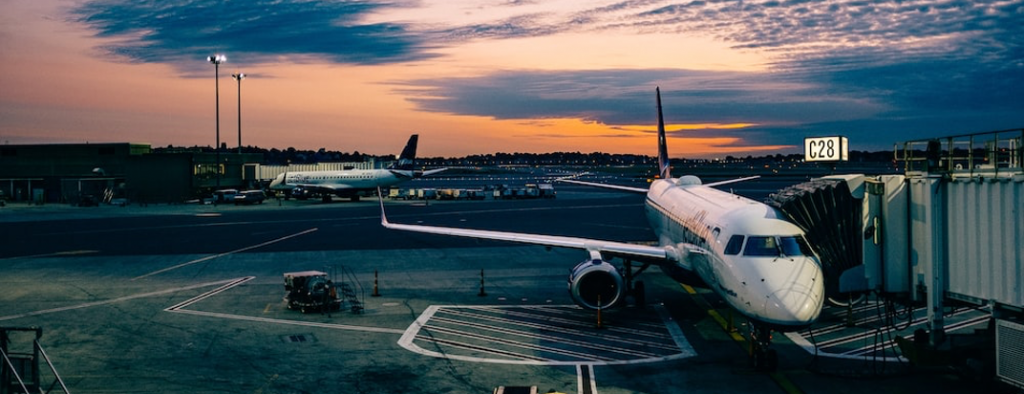
By: Reanna Hughes
As the number of people concerned about climate change increases, businesses are taking pledges to help combat the effects of pollution; companies are turning over a new leaf as they advertise their plans to have a green thumb. Delta Air, an air travel company, announced that by 2030 they will invest one billion dollars to the efforts of mitigating all emissions.[1] However, in 2022, Delta announced that they have transitioned their focus from carbon offset towards decarbonization; this means that Delta is now investing in biofuels.[2]
Carbon dioxide is approximately seventy percent of the exhaust that is emitted from an airplane.[3] The carbon dioxide that is emitted will mix into the air and produce a warming effect; unfortunately, it will take hundreds of years just for fifty percent of that carbon dioxide that is released into the air to disappear.[4] Carbon dioxide emissions have accelerated in the most recent years due to commercial air traffic.[5] The Environmental Protection Agency (“EPA”) states that over ten percent of the United States transportation emissions equates to three and a half percent of the total human involvement in global warming in the years 2011 and 2018.[6] It is also anticipated that the total annual number of international passengers to and from the United States will roughly be 446 million by 2041, this is a drastic increase from 67 million in 2020.[7] Commercial airlines need to implement alternatives to carbon dioxide output to mitigate the emission that they produce. Due to technology increasing, there are more viable options for alternatives: one being going electric or hybrid.[8] When the world realized the amount of carbon dioxide cars emitted, we turned to the technology of electric cars; now we are doing the same for airplanes.[9] Aribus is a company that is focusing on hybrid or electric airplanes to help combat carbon emissions.[10] Norway, a country with many islands, has promised they will have all their short-haul flights electric by 2040.[11] Even this change from one country could make a big difference in our environment.[12] The aviation industry has also thought of a different way to eliminate carbon emissions: alternative fuels.[13] These companies have looked into using vegetable oil and even diapers in jet fuels.[14] If airlines switch to biofuels, the carbon pollution that is caused by airlines could decrease by almost sixty percent.[15]
When there are big industries polluting, the government eventually has to step in and try to control the pollution to the best of their ability. The Clean Air Act, passed by Congress in 1970, allows for the EPA to have broad regulatory authority to implement emission standards for any class of aircraft engines.[16] Along with the EPA, the Federal Aviation Administration (“FAA”) created an aviation climate action plan that, if followed, will achieve net zero emissions by 2050 for the aviation industry.[17] This plan also highlights the need for more efficient engine and aircraft technologies in order to reach this goal.[18]
With the prediction that the growth of air travel will only increase, airlines need to focus their efforts on making their company more energy efficient and eliminating emissions that are being released from their planes. The aviation industry needs to implement the new technology that is available to prevent the exacerbation of climate change. Since climate change has become more prevalent as the years go on, there is an upward trend of people caring about the environment. This is exemplified by the class action lawsuit that is taking place due to Delta Airlines changing their company’s pledge of mitigating all emissions to investing in biofuels.[19] The need for people to come together to highlight the issue of emissions and fund new technologies that will achieve the goals of zero emissions is critical. The laws that are being put in place as well as the class action against Delta, convey that people have come to the realization that environmental issues are intensifying, and the aviation industry is only exacerbating the issue.
———————
Citations:
- DELTA AIR: Class Action Over Carbon-Neutral Claim Pending, Lexis Plus, (Sept. 1, 2023), https://plus.lexis.com/document/?pdmfid=1530671&crid=00ef709b-368a-4ea6-b27c-950d46990d30&pddocfullpath=%2Fshared%2Fdocument%2Flegalnews%2Furn%3AcontentItem%3A692T-86W1-F10V-7018-00000-00&pdcontentcomponentid=332176&pdworkfolderlocatorid=NOT_SAVED_IN_WORKFOLDER&prid=47160194-92bb-4fb5-b15f-f7637542eb31&ecomp=n74k&earg=sr13
2. Id.
3. Jeff Overton, The Growth in Greenhouse Gas Emissions from Commercial Aviation, Environmental and Energy Study Institute (June 9, 2022), https://www.eesi.org/papers/view/fact-sheet-the-growth-in-greenhouse-gas-emissions-from-commercial-aviation
4. Id.
5. Id.
6. Id.
7. Id.
8. Hybrid and electric flight, Airbus, https://www.airbus.com/en/innovation/low-carbon-aviation/hybrid-and-electric-flight, (last visited Sept. 9, 2023)
9. Id.
10. Id.
11. Jackie Snow, Greener air travel will depend on these emerging technologies, National Geographic, (Jan. 15, 2021), https://www.nationalgeographic.com/travel/article/greener-air-travel-will-depend-on-these-emerging-technologies
12. Id.
13. Id.
14. Id.
15. Id.
16. Sungjoo Ahn, EPA’s New Aviation Emissions Standard: Why It’s Already Obsolete, Environmental and Energy Law Program, (Feb. 25, 2021), https://eelp.law.harvard.edu/2021/02/epas-aviation-emissions-standard/#:~:text=Section%20231(a)(2)(A)%20of%20the%20Clean,which%20in%20his%20judgment%20causes%2C
17. Aviation Climate Action Plan, Federal Aviation Administration, https://www.faa.gov/sustainability/aviation-climate-action-plan, (last updated June 16, 2023).
18. Id.
19. DELTA AIR: Class Action Over Carbon-Neutral Claim Pending, Supra note 1.
